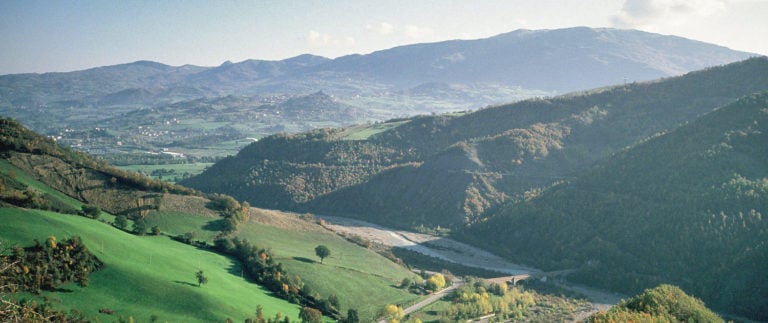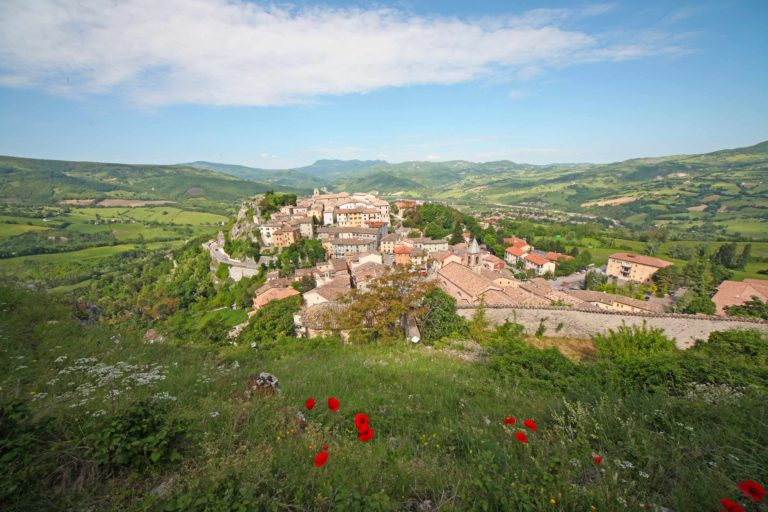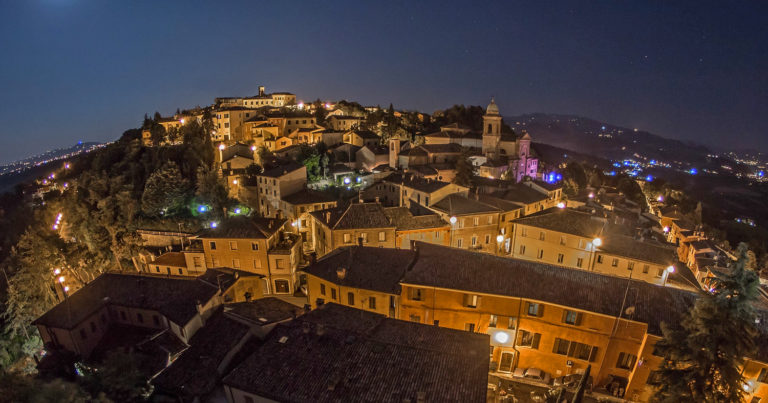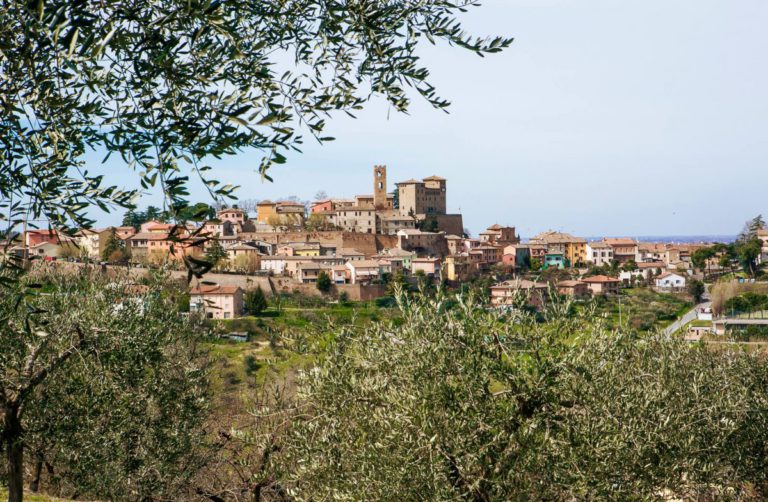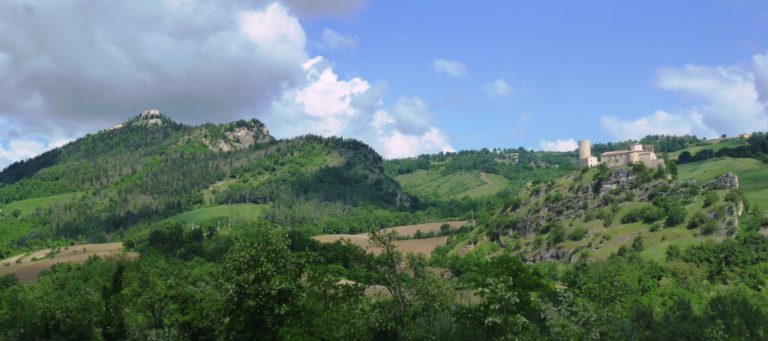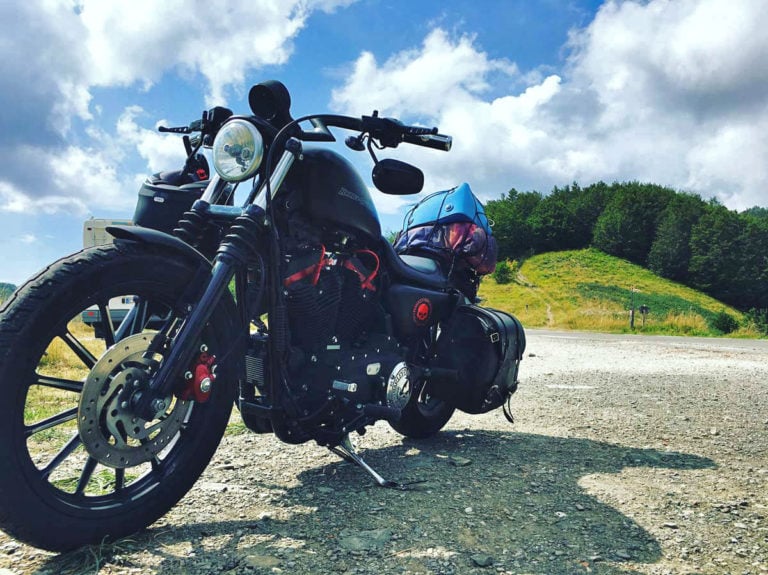A village, a fortress perched on a limestone and sandstone spur in the heart of the Montefeltro area.
A borderland, a theatre of cultural and ecclesiastical history. This, in a nutshell, is San Leo.
Its timeless charm has earned it the right to join the Borghi più Belli d’Italia (the association of Italy’s most beautiful little towns) as well as Orange Flag status. It is on the map in the upper Valmarecchia, inland from Rimini, nestling in the stunning landscapes among Tuscany, the Marche, and San Marino.
A visit to San Leo is a journey through history and culture – from the time of St Leo to the visit of St Francis, from the incarceration of Cagliostro and Orsini to the inspiration of Dante and the landscapes of Piero della Francesca.
San Leo is a place of outstanding cultural richness and natural beauty. It is a veritable vision, especially at sunrise or sunset. Its remarkable form, with its walls teetering 600 meters up on the clifftops, has always endowed it with dual military and religious importance.
San Leo is still an almost impregnable place, in a perpetual balancing act between the surrounding topography and the human hands shaping its fortress silhouette. Among the hills dotted with small settlements, a single road chiseled into the rock winds its way up to the village.
Inside the old gate, the pale, sand-colored stone buildings exude a tranquil, other-worldly mood with alleys and corners laced with poetry.
The castle looming over the cliff edge, in a panorama of woodlands and rocky peaks marching out to the Adriatic, resembles a boat tossed on a rocky sea and a fairy castle rising from the mists. Being a few degrees cooler than its surroundings, on account of its lofty position, it is a perfect destination for anyone seeking a fresh, relaxing contrast to the Romagna Riviera.
San Leo, view of the fortress Ph. carlo_grifone
San Leo History
The slab of rock holding up the village of San Leo and which lends its name to the whole area, the Montefeltro, would derive its name from the Latin Mons Feretri.
Mons Feretri was a Roman settlement built around a temple to Jupiter Feretrius (tradition has it that the temple is still under the contemporary cathedral.)
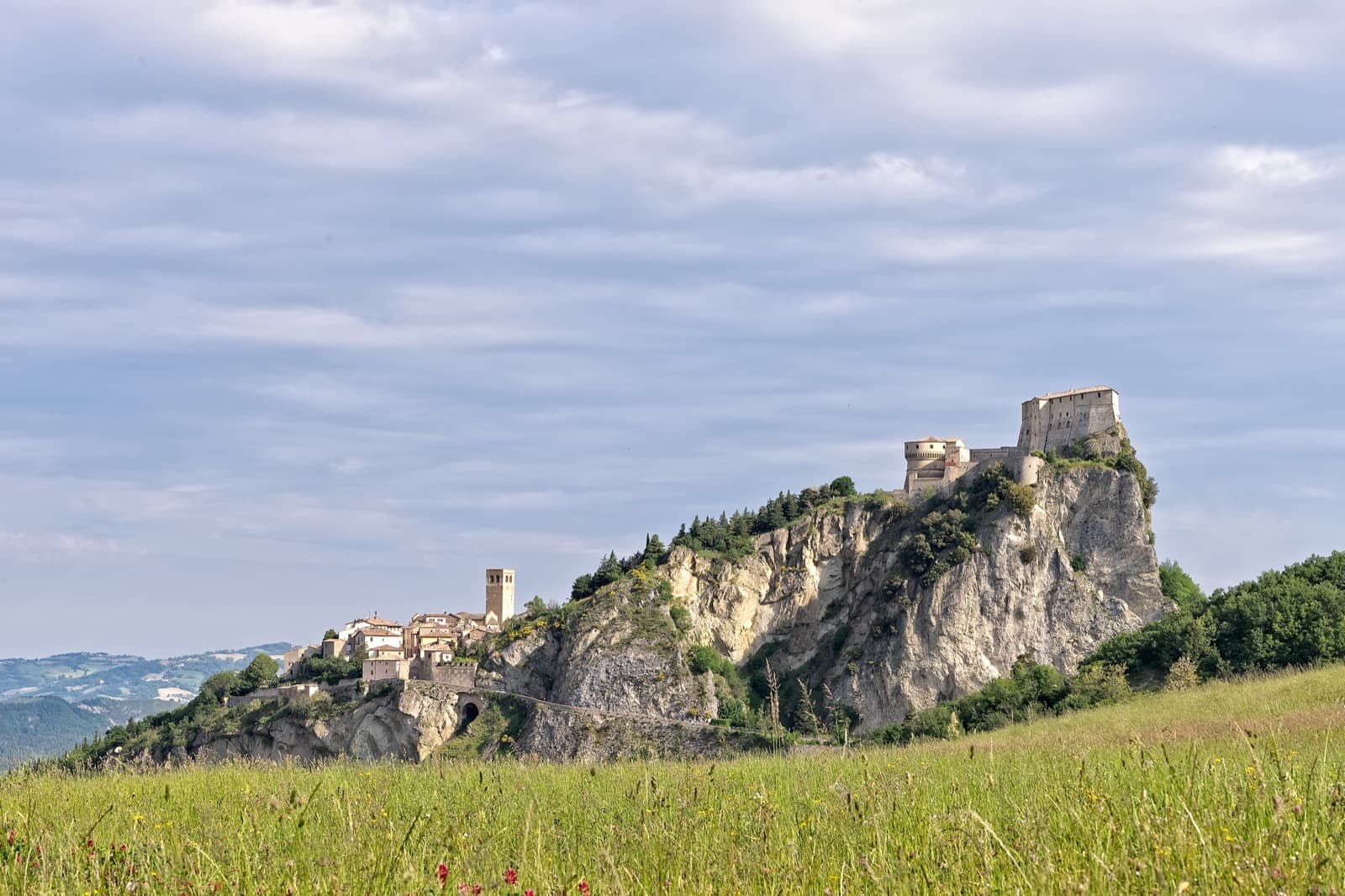
In the Middle Ages, it was fought over by the Byzantines, Goths, Franks, and Longobards, becoming the capital of Berengar II’s kingdom in the mid-10th century.
During the family feud between The Malatesta of Rimini and the Montefeltro of Urbino, San Leo becomes a disputed territory, until the Montefeltro family prevailed in 1441 with Duke Federico.
From that time, San Leo was part of the Marche region and the Urbino province until 15 August 2009, when – for a strange game of fate – it joined Rimini province along with six other municipalities in the High Valmarecchia area after a referendum, renewing its history of land disputed between two cities.
What to see in San Leo
San Leo’s most striking feature is undoubtedly its impressive castle, towering at an altitude of 639 m over the imposing rock walls that have made it impregnable.
The museum has a fascinating collection of prints, paintings, furniture, and ceramics along with extensive records on the key figures in the village’s history, from Berengar to the Montefeltro family.
The beautiful exhibition of weapons and armor from the fourteenth to the nineteenth century is certainly worth a visit, together with the basement, including Cagliostro’s cell.
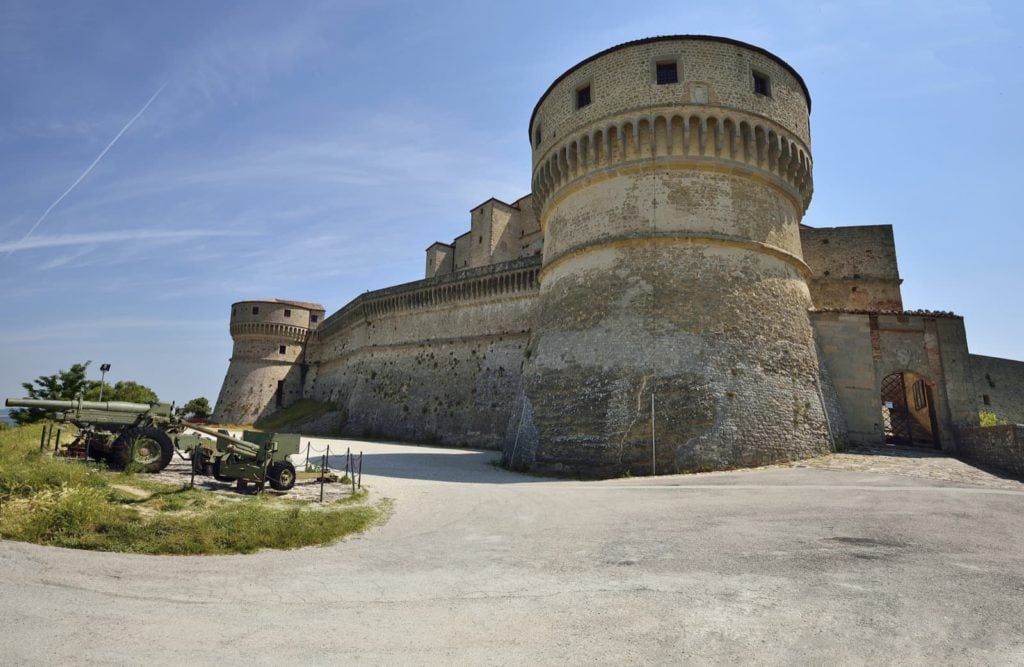
The village’s oldest building is the parish church built in the Carolingian era. It was remodeled in Romanesque stone, it stands on the original cell where St Leo retired in prayer and lived his last few years as a hermit. It is made of material retrieved from the Roman era, in a basilica plan with three aisles demarked by pillars and columns.
The nearby cathedral, dedicated to St Leo, was erected near the cliff edge in the 7th century and completely renovated in 1173 in sandstone in a Lombard Romanesque style. The mighty square bell tower, probably of Byzantine origin, offers some superb views over the village.
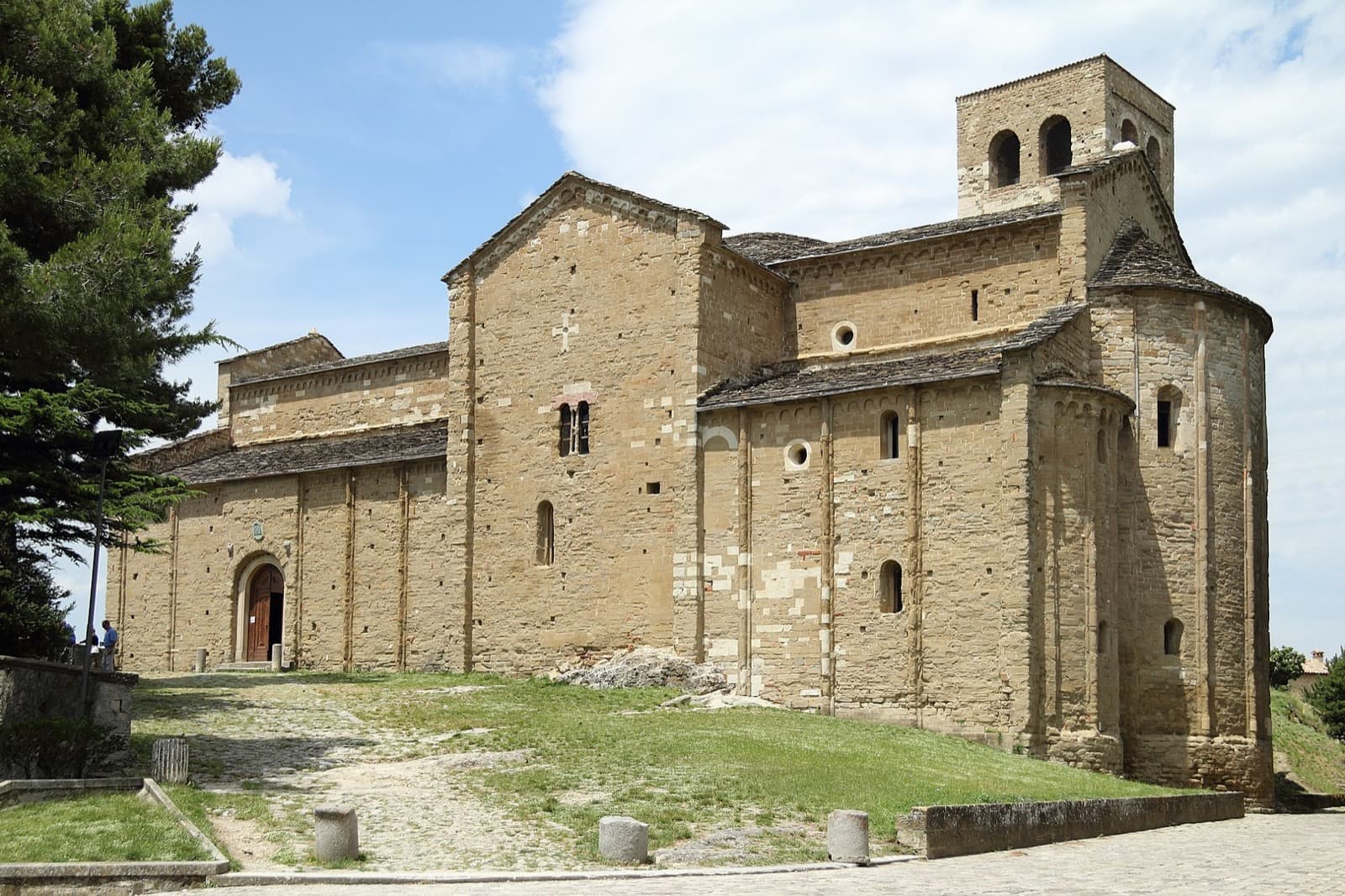
The Medici Palace, built on behalf of the Republic of Florence for the governor of San Leo and Montefeltro, now houses the Museum of Sacred Art and the picture gallery. The museum offers artworks and furnishings from various churches from the 9th to the 18th century, while the gallery contains works by Guercino and Caravaggio, among others.
Piazza Dante is the heart of the medieval village, while the town hall, Palazzo Della Rovere is the place where the Sanctuary of La Verna was donated to St Francis as a gift in 1213.
About a mile or so from the hamlet stands the monastery of St Igne, considered to have been founded by St Francis. It dates back to the 13th century, and its cloister contains a piece of the trunk of the oak under which the saint preached.
What to do in San Leo
Spring – Explore the San Leo area from the sky with a paraglider or hang-glider from the Mount San Severino crag.
Summer – Go hunting for the landscapes that inspired the world-famous Renaissance artist Piero della Francesca.
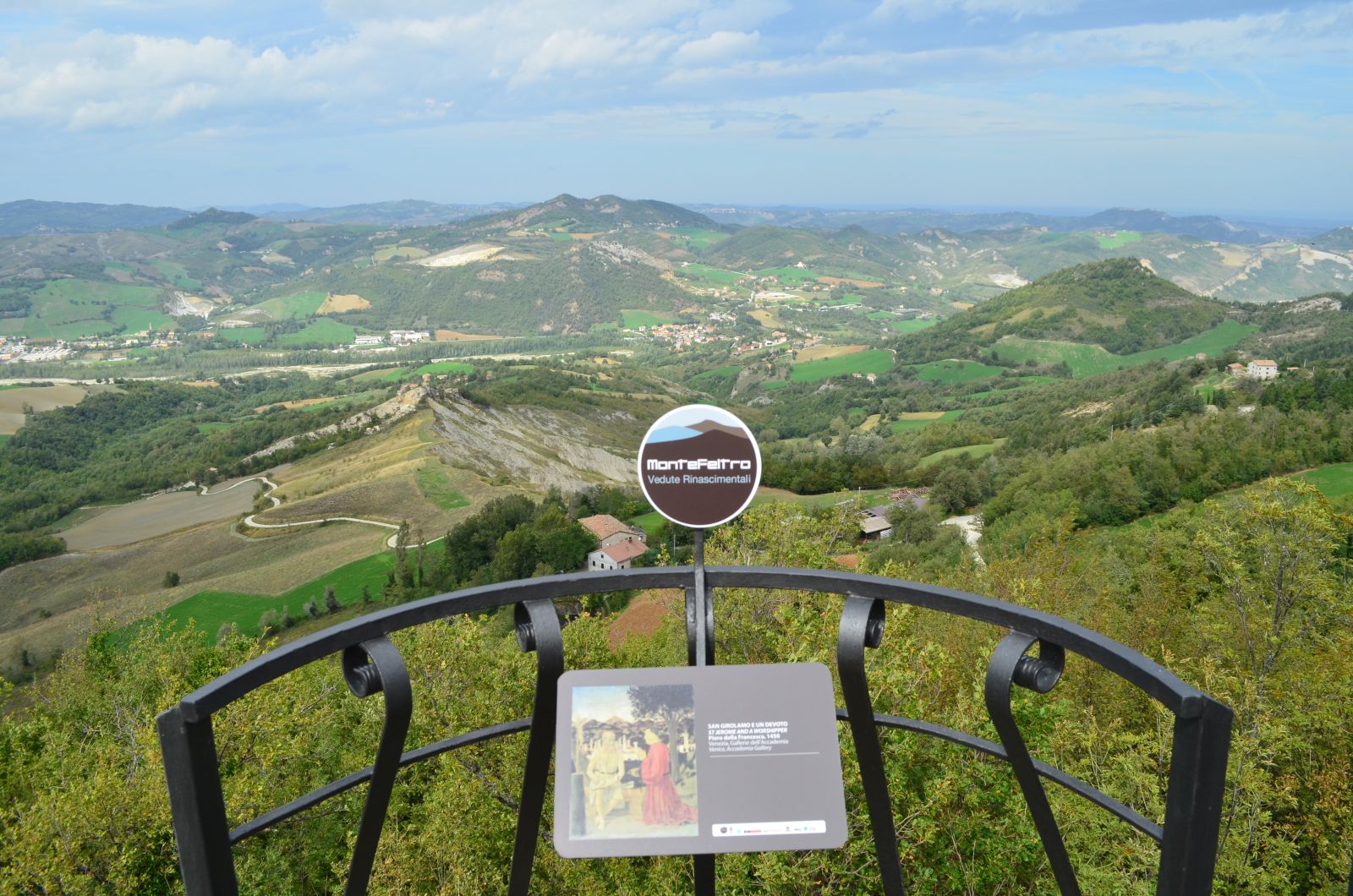
Autumn – Discover Montefeltro’s natural heritage with a visit to the nearby Sasso Simone and Simoncello Natural Park.
Winter – Explore the village, which is often wreathed in an atmospheric mist, and visit the Christmas market during the festive season in nearby Sant’Agata Feltria.
San Leo Events
Cherry Festival – last weekend of May
The Festa dal Zarisi is a traditional festival of a delicious local product, just down the valley in Pietracuta di San Leo.
San Leo festival – July-August
This prestigious musical and cultural event has always embraced a variety of genres. Performances are staged in the Romanesque cathedral and in the great castle tower.
AlchimiAlchimie – late August
Several days are devoted to celebrating Giuseppe Balsamo, the Count of Cagliostro, as magic and esotericism fill the old streets with themed markets, music, fireworks, and dance.
Please, take note that the reported events are among those that usually take place every year in San Leo.
We advise you to call the local tourist office for all the relevant information
Food and Wine
The Montefeltro area offers not only cultural treasures but also fine food and wine.
For a traditional menu of local delicacies, try traditional local tortelloni followed by a Rabbit with wild fennel.
For fine diners, we suggest not to miss the Cagliostro-style Casserole, and local Pecorino cheese wrapped in walnut leaves with a few drops of Valmarecchia honey.
We also strongly suggest tasting Sangiovese Superiore wine, a lesser-known brother of the most famous Chianti that on these hills it grew at its best.
If you are a lover of the traditional Italian “Digestivo”, we also recommend a glass of Balsamo di Cagliostro, the village’s traditional digestif made from licorice root, invented, as legend would have it, by the count himself.
San Leo Famous Characters
Cagliostro – The Count, who is also mentioned in the Divine Comedy and whose fame as a healer and alchemist reached the most important courts in Europe, was imprisoned in the castle dungeon for heresy and sedition. Cagliostro is also the main character of “Lupin III: The Castle of Cagliostro”, the Japanese animated action-adventure comedy film co-written and directed by Hayao Miyazaki.
It seems in fact that the Japanese director was inspired by the story of the Count in writing the screenplay.
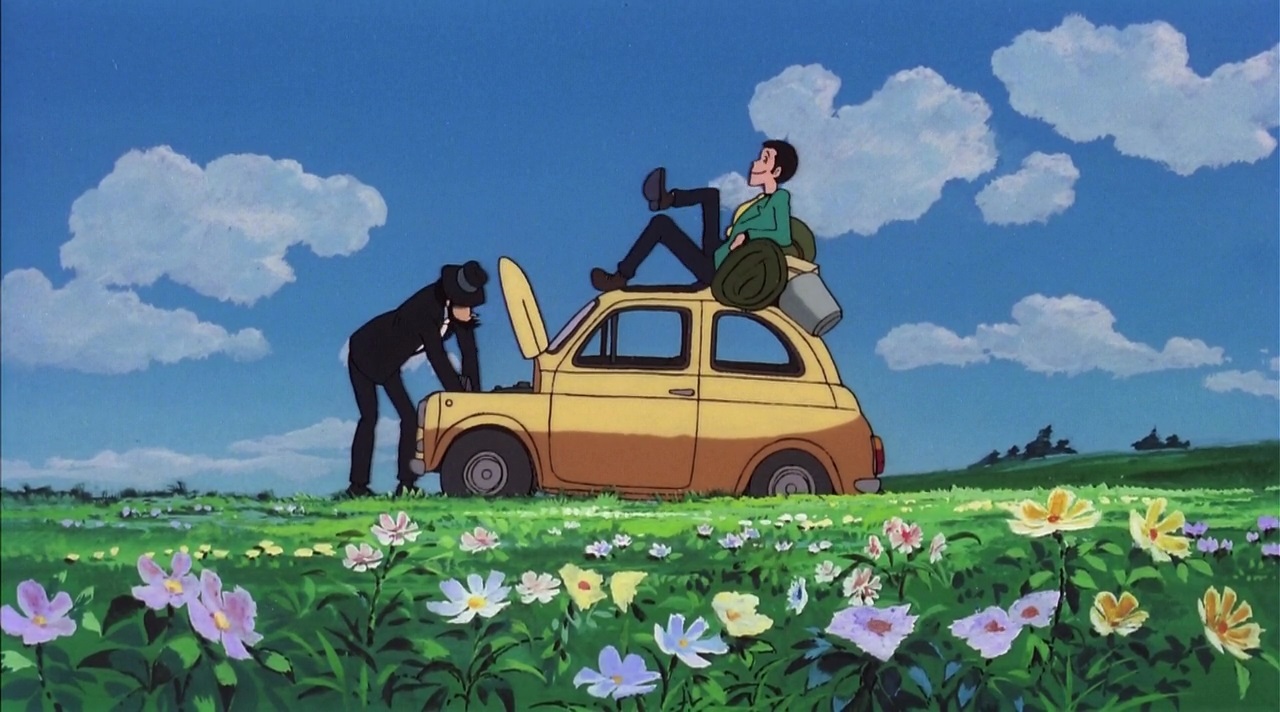
Felice Orsini – The revolutionary and follower of Mazzini born in nearby Meldola is known for his attempt to assassinate Emperor Napoleon III in Paris. Four years earlier, he had been incarcerated with his father and other Roman patriots in the “Fort of Saint Leo, where incorrigible revolutionary convicts are imprisoned”. St Leo, the village’s patron saint, came here in the late 3rd-century ad from Dalmatia to escape Emperor Diocletian’s persecution of the Christians.
St Francis – On 8 May 1213, Count Orlando Catani of Chiusi in Casentino gave St Francis the gift of Mount Verna, where the Sanctuary of the Verna was built; this is where he received the stigmata. The saint’s image has been incorporated into the town’s coat of arms, and the villagers commemorate the donation in a celebration every May.
Pilgrim paths and walking trails
Hikers looking for new excursions may be interested to know that San Leo is the departure point for the 3rd stage of the St Francis Way, from Rimini to La Verna Sanctuary.
How to get to San Leo
San Leo is about 30 km from Rimini, and it can be reached:
by car: 32 km from Rimini, Statale 258 direction Arezzo, in Pietracuta turn left. The journey takes about 45 minutes.
by bus: bus lines provide daily service, with transfer in Pietracuta.
by bike: There are some beautiful cycling routes that lead to San Leo we recommend.
From Rimini see directions for Verucchio, then proceed along Statale 258 from Pietracuta to San Leo. The first part of the route is of medium difficulty while the last few kilometers are very difficult.
The ride should take about 1 hour and 40 minutes.
This section is dedicated to Villages that are part of the Associations Borghi più belli d’Italia, Bandiere Arancioni del Touring Club & Borghi autentici d’Italia.
Author
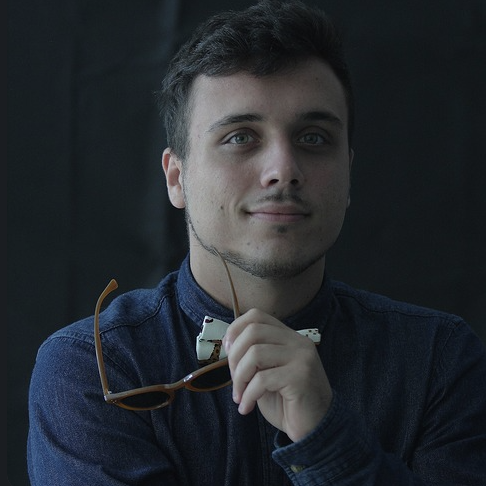
Arturo Castellini
I am a curious explorer from Emilia-Romagna and usually spend my time planning my next trip, searching for the most authentic traditions of the Italian hinterland.
You may also like
Dolce Vita in Valmarecchia: an itinerary among hamlets and hills
by Elisa Mazzini /// June 7, 2016
Pennabilli, one of the most beautiful villages in Emilia-Romagna
by Davide Marino /// September 14, 2017
The village of Verucchio: from the Etruscans to the Malatesta Family
by Arturo Castellini /// October 12, 2017

Interested in our newsletter?
Every first of the month, an email (in Italian) with selected contents and upcoming events.
8 unmissable Castles in the lands of Guidi and Malatesta
by Walter Manni /// April 13, 2018
Saint Francis’s walk from Rimini to La Verna
by Arturo Castellini /// October 20, 2017
